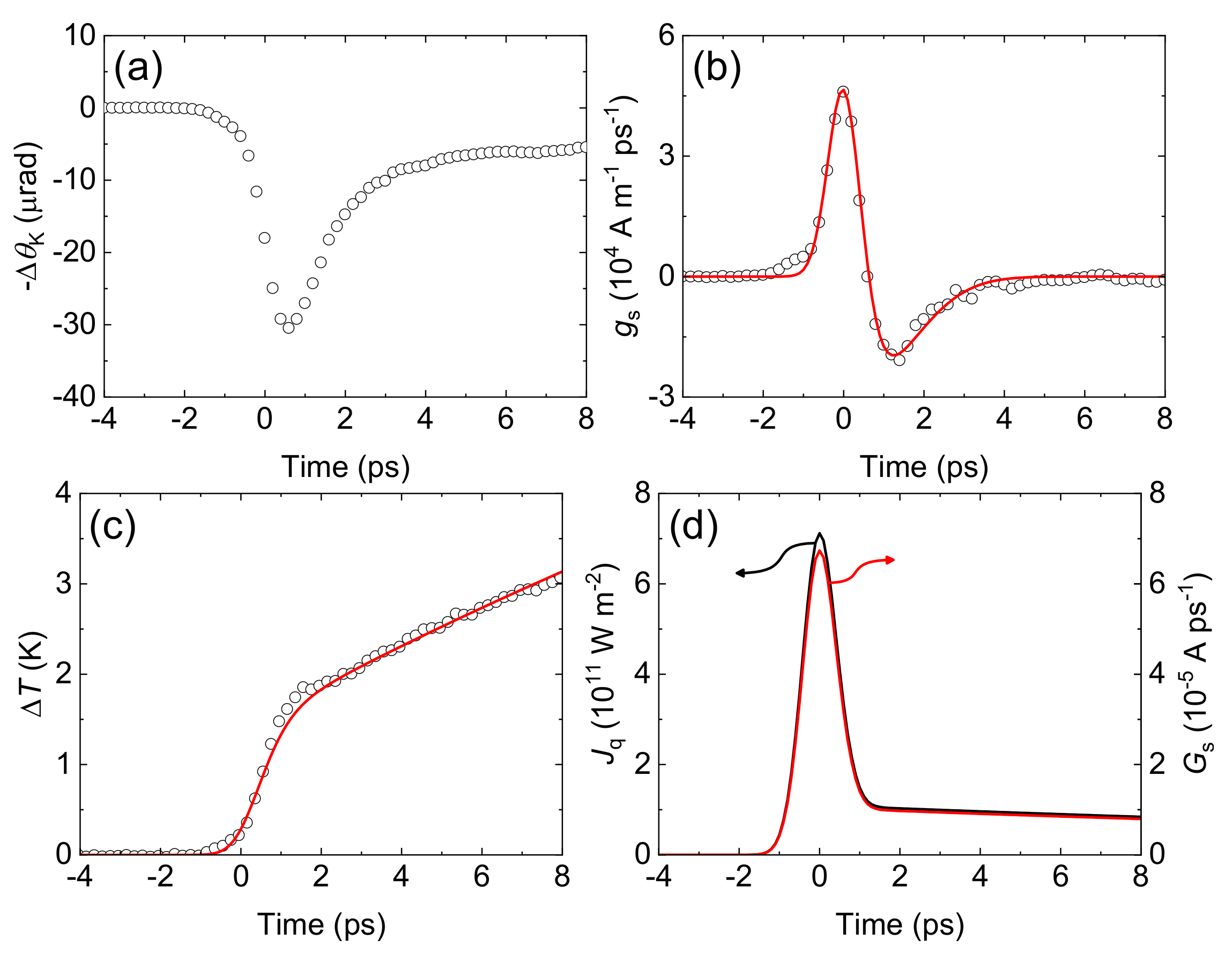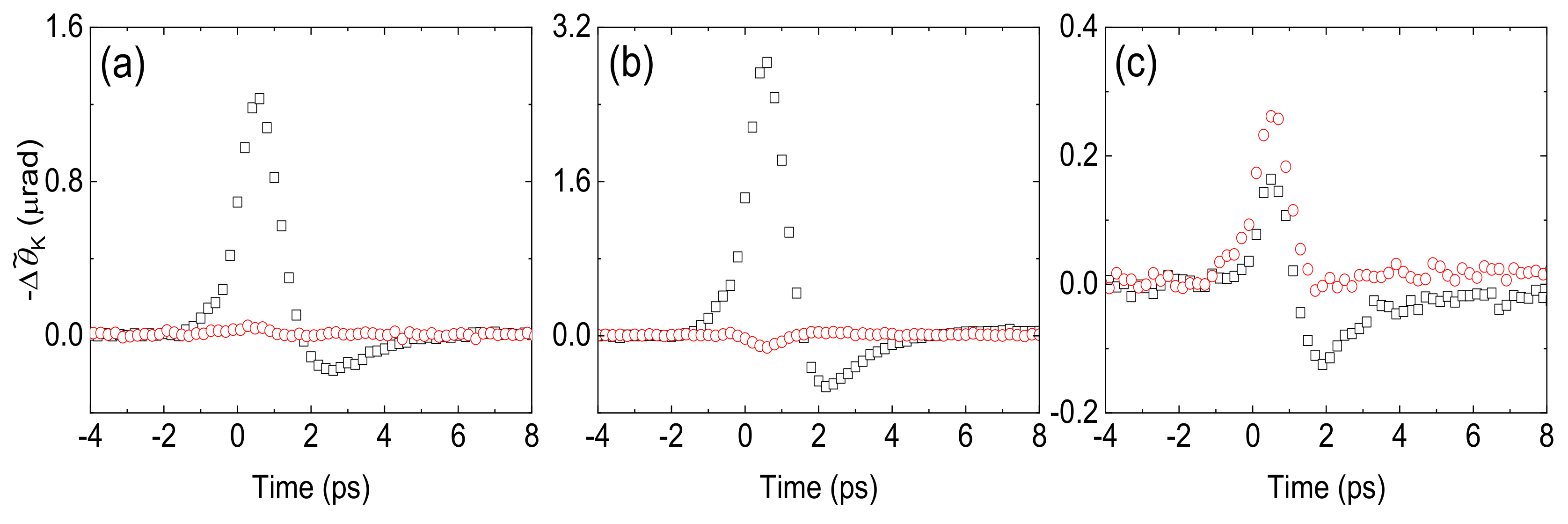Magneto-Optical Kerr Effect Driven by Spin Accumulation on Cu, Au, and Pt
Abstract
:Featured Application
Abstract
1. Introduction
2. Materials and Methods
3. Results
4. Discussion
Author Contributions
Funding
Acknowledgments
Conflicts of Interest
References
- Faraday, M. Experimental researches in electricity.—Nineteenth series. Philos. Trans. R. Soc. Lond. 1846, 136, 1–20. [Google Scholar] [CrossRef]
- Kerr, J. On rotation of the plane of polarization by reflection from the pole of a magnet. Philos. Mag. J. Sci. 1877, 3, 321–343. [Google Scholar] [CrossRef]
- Ebert, H. Magneto-optical effects in transition metal systems. Rep. Prog. Phys. 1996, 59, 1665–1735. [Google Scholar] [CrossRef]
- Stern, E.A.; McGgroddy, J.C.; Harte, W.E. Polar refection Faraday effect in metals. Phys. Rev. 1964, 135, A1306–A1314. [Google Scholar] [CrossRef]
- McGgroddy, J.C.; McAlister, A.J.; Stern, E.A. Polar refection Faraday effect in silver and gold. Phys. Rev. 1965, 139, A1844–A1848. [Google Scholar] [CrossRef]
- Schnatterly, S.E. Magetoreflection measurements on the noble metals. Phys. Rev. 1969, 183, 664–667. [Google Scholar] [CrossRef]
- Uba, L.; Uba, S.; Antonov, V.N. Magneto-optical Kerr spectroscopy of platinum. Phys. Rev. B 2000, 62, 16510–16521. [Google Scholar] [CrossRef]
- Uba, L.; Uba, S.; Antonov, V.N. Magneto-optical Kerr spectroscopy of noble metals. Phys. Rev. B 2017, 96, 235132. [Google Scholar] [CrossRef]
- Choi, G.M.; Min, B.C.; Lee, K.J.; Cahill, D.G. Spin current generated by thermally driven ultrafast demagnetization. Nat. Commun. 2014, 5. [Google Scholar] [CrossRef] [PubMed]
- Choi, G.M.; Cahill, D.G. Kerr rotation in Cu, Ag, and Au driven by spin accumulation and spin-orbit coupling. Phys. Rev. B 2014, 90, 214432. [Google Scholar] [CrossRef]
- Hofherr, M.; Maldonado, P.; Schmitt, O.; Berritta, M.; Bierbrauer, U.; Sadashivaiah, S.; Schellekens, A.J.; Koopmans, B.; Steil, D.; Cinchetti, M.; et al. Speed and efficiency of femtosecond spin current injection into a nonmagnetic material. Phys. Rev. B 2017, 96, 100403. [Google Scholar] [CrossRef]
- Dyakonov, M.I.; Perel, V.I. Possibility of orienting electron spins with current. JETP Lett. 1971, 13, 657–660. [Google Scholar]
- Hirsch, J.E. Spin Hall effect. Phys. Rev. Lett. 1999, 83, 1834–1837. [Google Scholar] [CrossRef]
- Sinova, J.; Valenzuela, S.O.; Wunderlich, J.; Back, C.H.; Jungwirth, T. Spin Hall effects. Rev. Mod. Phys. 2015, 87, 1213–1259. [Google Scholar] [CrossRef]
- Riego, P.; Vélez, S.; Gomez-Perez, J.M.; Arregi, J.A.; Hueso, L.E.; Casanova, F.; Berger, A. Absence of detectable current-induced magneto-optical Kerr effects in Pt, Ta, and W. Appl. Phys. Lett. 2016, 109, 17402. [Google Scholar] [CrossRef]
- Su, Y.; Wang, H.; Li, J.; Tian, C.; Wu, R.; Jin, X.; Shen, Y.R. Absence of detectable MOKE signals from spin Hall effect in metals. Appl. Phys. Lett. 2016, 109. [Google Scholar] [CrossRef]
- Stamm, C.; Murer, C.; Berritta, M.; Feng, J.; Gabureac, M.; Oppeneer, P.M.; Gambardell, P. Magneto-optical detection of the spin Hall effect in Pt and W thin films. Phys. Rev. Lett. 2017, 119, 087203. [Google Scholar] [CrossRef]
- Choi, G.M.; Moon, C.H.; Min, B.C.; Lee, K.J.; Cahill, D.G. Thermal spin-transfer torque driven by the spin-dependent Seebeck effect in metallic spin-valves. Nat. Phys. 2015, 11, 576–581. [Google Scholar] [CrossRef]
- Daalderop, G.H.O.; Kelly, P.J.; Broeder, F.J.A. Prediction and confirmation of perpendicular magnetic anisotropy in Co/Ni multilayers. Phys. Rev. Lett. 1992, 68, 682–685. [Google Scholar] [CrossRef] [PubMed]
- You, L.; Sousa, R.C.; Rodmacq, B.; Dieny, B. Co/Ni multilayers with perpendicular anisotropy for spintronic device applications. Appl. Phys. Lett. 2012, 100, 172411. [Google Scholar] [CrossRef]
- Gweon, H.K.; Yun, S.J.; Lim, S.H. A very large perpendicular magnetic anisotropy in Pt/Co/MgO trilayers fabricated by controlling the MgO sputtering power and its thickness. Sci. Rep. 2018, 8, 1–8. [Google Scholar] [CrossRef] [PubMed]
- Tari, A. The Specific Heat of Matter at Low Temperatures; Imperial College Press: London, UK, 2003; ISBN 978-1-86094-314-0. [Google Scholar]
- Sagasta, E.; Omori, Y.; Isasa, M.; Gradhand, M.; Hueso, L.E.; Niimi, Y.; Otani, Y.C.; Casanova, F. Tuning the spin Hall effect of Pt from the moderately dirty to the superclean regime. Phys. Rev. B 2016, 94, 060412. [Google Scholar] [CrossRef]
- Jedema, F.J.; Nijboer, M.S.; Filip, A.T.; van Wees, B.J. Spin injection and spin accumulation in all-metal mesoscopic spin valves. Phys. Rev. B 2003, 67, 085319. [Google Scholar] [CrossRef]
- Kimura, T.; Sato, T.; Otani, Y. Estimation of spin-diffusion length from the magnitude of spin-current absorption: Multiterminal ferromagnetic/nonferromagnetic hybrid structures. Phys. Rev. B 2005, 72, 014461. [Google Scholar] [CrossRef]
- Sharma, A.; Romero, J.A.; Theodoropoulou, N.; Loloee, R.; Pratt, W.P., Jr.; Bass, J. Specific resistance and scattering asymmetry of Py/Pd, Fe/V, Fe/Nb, and Co/Pt interfaces. J. Appl. Phys. 2007, 102, 113916. [Google Scholar] [CrossRef]
- Bass, J.; Pratt, W.P., Jr. Current-perpendicular (CPP) magnetoresistance in magnetic metallic multilayers. J. Magn. Magn. Mater. 1999, 200, 274–289. [Google Scholar] [CrossRef]
- Moreau, C.E.; Moraru, I.C.; Birge, N.O.; Pratt, W.P., Jr. Measurement of spin diffusion length in sputtered Ni films using a special exchange-biased spin valve geometry. Appl. Phys. Lett. 2007, 90. [Google Scholar] [CrossRef]
- Henry, L.L.; Yang, Q.; Holody, P.; Loloee, R.; Pratt Jr., W.P.; Bass, J. Perpendicular interface resistances in sputtered Ag/Cu, Ag/Au, and Au/Cu multilayers. Phys. Rev. B 1996, 54, 12336–12341. [Google Scholar] [CrossRef]
- Kurt, H.; Loloee, R.; Eid, K.; Pratt, W.P., Jr.; Bass, J. Spin-memory loss at 4.2 K in sputtered Pd and Pt and at Pd/Cu and Pt/Cu interfaces. Appl. Phys. Lett. 2002, 81, 4787–4789. [Google Scholar] [CrossRef]
- Weller, D.; Harp, G.R.; Farrow, R.F.C.; Cebollad, A.; Sticht, J. Orientation dependence of the polar Kerr effect in fcc and hcp Co. Phys. Rev. Lett. 1994, 72, 2097–2100. [Google Scholar] [CrossRef] [PubMed]
- Visnovsky, S.; Parizek, V.; Nyvlt, M.; Kiela, P.; Prosser, V.; Krishnan, R. Magneto-optical Kerr spectra of nickel. J. Magn. Magn. Mater. 1993, 127, 135–139. [Google Scholar] [CrossRef]
- Alekhin, A.; Razdolski, I.; Ilin, N.; Meyburg, J.P.; Diesing, D.; Roddatis, V.; Rungger, I.; Stamenova, M.; Sanvito, S.; Bovensiepen, U.; et al. Femtosecond spin current pulses generated by the nonthermal spin-dependent Seebeck effect and interaction with ferromagnets in spin valves. Phys. Rev. Lett. 2017, 119, 017202. [Google Scholar] [CrossRef] [PubMed]
- Liu, L.; Buhrman, R.A.; Ralph, D.C. Review and Analysis of Measurements of the Spin Hall Effect in Platinum. arXiv, 2011; arXiv:1111.3702. [Google Scholar]





| Parameter | Pt | [Co/Ni] | Cu | Au |
|---|---|---|---|---|
| γ (J m−3 K−2) | 721 a | 930 b | 97 a | 97 a |
| Ns (eV−1 nm−3) | 92 | 118 | 13 | 9 |
| σ (106 Ω−1 m−1) | 6.6 c | 3 c | 39 c | 27 c |
| D (nm2 ps−1) | 220 | 80 | 9500 | 9800 |
| ls (nm) | 4 d | 2.8 e | 400 f | 60 g |
| τs (ps) | 0.07 | 0.1 | 17 | 0.4 |
| Parameter | Pt/[Co/Ni] | [Co/Ni]/Cu | Cu/Au | Cu/Pt |
|---|---|---|---|---|
| G (1015 Ω−1 m−2) | 1.5 a | 3 b | 6.7 c | 1.3 d |
© 2018 by the author. Licensee MDPI, Basel, Switzerland. This article is an open access article distributed under the terms and conditions of the Creative Commons Attribution (CC BY) license (http://creativecommons.org/licenses/by/4.0/).
Share and Cite
Choi, G.-M. Magneto-Optical Kerr Effect Driven by Spin Accumulation on Cu, Au, and Pt. Appl. Sci. 2018, 8, 1378. https://doi.org/10.3390/app8081378
Choi G-M. Magneto-Optical Kerr Effect Driven by Spin Accumulation on Cu, Au, and Pt. Applied Sciences. 2018; 8(8):1378. https://doi.org/10.3390/app8081378
Chicago/Turabian StyleChoi, Gyung-Min. 2018. "Magneto-Optical Kerr Effect Driven by Spin Accumulation on Cu, Au, and Pt" Applied Sciences 8, no. 8: 1378. https://doi.org/10.3390/app8081378





